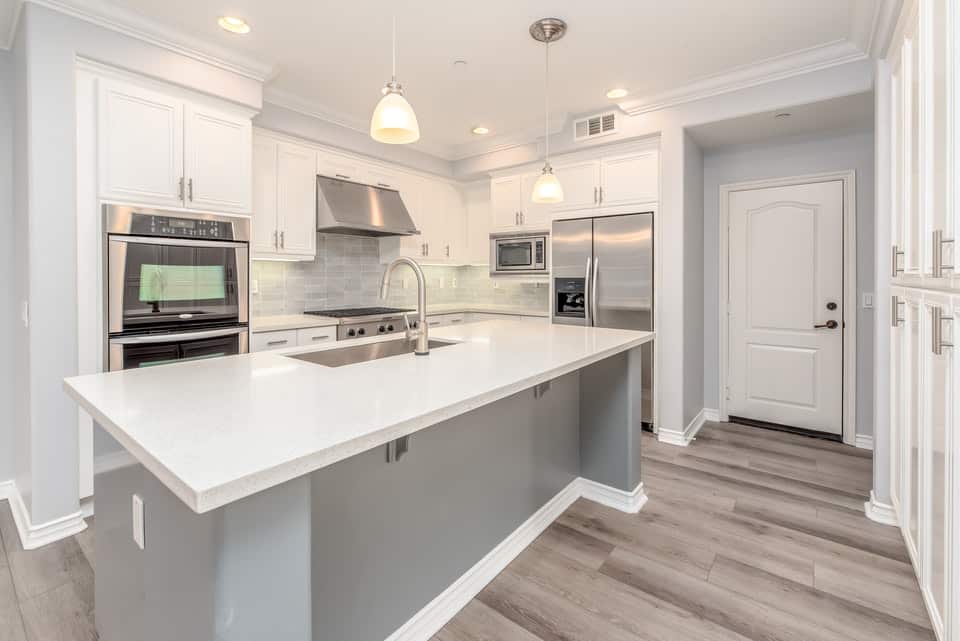Real estate photos are the first things buyers see when searching for a home online. High-quality images even help people envision themselves living in the house. Well-done real estate photography captures a property at its best angle, showcases its unique features, and hopefully helps it sell for top dollar.
But as with any photography niche, it requires special knowledge. Here are all the real estate photography tips you need to know, from equipment and lighting to staging and settings.
What Equipment Do You Need in Real Estate Photography?
One advantage of real estate photography is that you don’t need very much specialized equipment. All it takes is a camera, lens, and tripod. That said, additional equipment will make your job easier and your photos better.
Invest in a Full Frame Camera
Full frame cameras work best for real estate photography. Their large sensors give them a broad field of view and lead to higher quality photos.
If a full frame camera is outside your price range, you can usually achieve professional-looking photos with any camera with switchable lenses and high-functioning ISO abilities.
Source: Unsplash
Select a Wide Angle Lens
Wide angle lenses might be even more crucial than the camera in real estate photography. Wwide angle lenses manages to make spaces appear larger and increase the feeling of depth. Wide angle lenses also excel in depicting small spaces because of their ability to make them look more spacious.
Tilt-shift lenses, though expensive, are another excellent option for real estate photography. They reduce the distortion you may find with wide angle lenses.
A Tripod is A Necessity
Tripods are essential for real estate photography because they help you maintain consistency in your shots. Tripods prevent motion blur by steadying your camera and stabilize long exposure shots.
Tripods help maintain perspective in photos, too, which is crucial for real estate photography since you want potential buyers to get a genuine feel for the property.
Don’t Forget Flash
Many photographers are leery of flash, but it’s one of the best photography tips for real estate photography. The flash built into your camera may be too weak, so you might need to add external flashes to your equipment. Perfect for shooting properties with low lighting, external flashes are also portable and easy to move around the shoot.
With these devices, you can choose from monolights and flashguns. Flashguns are less expensive, but monolights are probably a bit more effective thanks to their better light output.
Don’t forget a flash trigger, either, which allows you to use your flash devices without touching the camera, reducing the blur caused by shaking.
Use a Remote Trigger for Steady Shots
Remote triggers are useful if you are using low shutter speed, and they help you avoid camera shake and distorted pictures.
If It’s Sunny, Remember Polarizing Filters
Polarizing filters work best for exterior photos in real estate photography. On very sunny days, they prevent overexposure and loss of detail.
You may want to double-check that the filter is the correct size for your lens and that it’s a circular filter.
Use an Umbrella to Modify Light
The most useful light modifier in real estate photography is a light and portable umbrella. It works perfectly for rooms with high ceilings and situations where you may not get enough bounce light to soften a shot.
You may also want to bring some umbrella brackets along. They will help you place your umbrella in the optimal position.
Other Useful Equipment
Light stands are necessary for supporting your flash devices and keeping your lighting even. Sandbags help stabilize your umbrellas and light stands, and they protect the home and your equipment from damage caused by falling.
Extra batteries and chargers are smart accessories for real estate photography, as are a backup camera and additional memory cards.
Cleaning supplies, like a handheld vacuum, duster, and window cleaner, may come in handy, too.
Prepare for Your Shoot Carefully
Preparation ensures a smooth real estate photography shoot from start to finish. Here are several photography tips to keep your real estate session on track.
Get Ready the Night Before the Shoot
To adequately prepare, check all of your equipment and pack it up safely. Make sure it all works, along with your backup equipment.
It’s also wise to check the property’s address, so you know how long it will take you to get there. Late arrival can seem unprofessional and will probably delay the shoot.
Aim for Daytime Sessions
Daytime is always best for real estate photography since you get tons of natural lighting and vibrant colors that make the photos pop.
Some real estate photographers enjoy shooting at sunset, or magic hour, for the fantastic lighting and striking shots. Just make sure the sun is behind the property for more flattering light.
Source: Pexels
Develop a Shot List
There are standard shots that every real estate photographer must capture in each property. Making a list of the key areas guarantees you won’t forget one by mistake. Plus, providing real estate agents with a list of your shots helps them prepare the house for its photoshoot.
Capture Warmth in the Living Room
The primary mission in the living room is to make it look as large as possible. You want to capture a welcoming atmosphere that the buyers can picture themselves in. Two wide-angle shots should be adequate for this space.
Functionality in the Kitchen and Dining Room
You want this area to look functional and clean. Make sure you remove all clutter and appliances from the countertops and tables. Remove everything from the fridge, too, including magnets. Placing nice dishes on the table can help it look useable.
Source: Pixabay
Standard Bedroom Shots
Two shots of each bedroom usually suffice, but be sure to capture anything that sets it apart from an ordinary bedroom, like a fantastic view.
You do not have to shoot the closet unless it may be considered a selling point for its customizations or size.
Bathroom Angles
Bathrooms are typically the smallest room you will shoot in real estate photography, and you may have to work a bit to find the right angle. Ensure the toilet lid is down, and there’s no clutter on the counters or in the shower area.
Highlight Curb Appeal
Add a couple of photos of the front of the property, particularly if it has great curb appeal. Time of day is crucial in shooting the exterior, and you should aim for plenty of sunlight to make the home look inviting.
Snap a few shots of the backyard, too, including anything unique. One of the newest tips for real estate photography is to use a drone. Drones make real estate photography aerial and give buyers a great look at the size of the lot.
Prepare the Property
Here are several quick steps to ready the home for real estate photography.
Get Rid of Clutter
Even though we may not notice it in our own homes, clutter becomes instantly recognizable in real estate photography. The real estate agent can let the homeowner know to keep their surfaces clean and clutter-free. You will want to check countertops, tables, desks, and any other flat surface that collects debris.
If you arrive at the property and find there’s still tons of clutter, like decorations, you can politely suggest that the photos may look better without the additional items.
Capitalize on Natural Lighting by Opening Windows
Natural light always looks great in real estate photography, especially when you have large windows. It brings out the brightness of the colors already in the home and gives a realistic feeling to your photos. Open blinds and curtains to let in all of the sunlight you can.
Source: Pexels
Do a Walk-Through of the Home
Taking a quick walkthrough allows you to get a feel for the house. It also helps you establish the order in which you will take your photos, starting with the spaces that are ready and working towards the ones that still need some tidying up.
You can take preliminary shots to get a better understanding of the house’s vibe and where you want to focus your professional photos. It helps you catch details you may have overlooked otherwise.
What About the Lights?
Turning the lights on will make a room look warmer and welcoming but makes editing photos more challenging because of the variable light temperatures. Meanwhile, keeping the lights off preserves even light temperature but may appear cold in photos.
Whenever possible, you want to utilize natural light in real estate photography. If there’s not much natural light, you will have to use your own judgment to decide how that particular home would photograph better.
For example, if the lights in the home have different color temperatures, it’s best to leave them off and use your flash equipment instead.
Furnish Rooms When Needed
While you don’t want to clutter a space, making sure a room has furniture gives it scale, highlights functionality, and makes it look more homely. Empty spaces, even if large and with plenty of light, often photograph cold.
Advice to Consider During the Session
As you photograph the property, try to remember these top real estate photography tips.
Try Imaginative Angles
Creative angles can add interest to your photos and make them stand out from ordinary real estate shots. Try to avoid shooting from corners since those shots tend to look conventional and may even make the room appear smaller than it actually is.
Ideally, the angles you use to shoot will highlight the house’s details and make it look spacious.
Focus on Your Camera Settings
Each property you photograph is unique and will require particular setting adjustments, mostly in the aperture, shutter speed, and ISO.
Most real estate photographers use an aperture between f/8 to f/11 and a shutter speed between 1/60 and ½ of a second. Although, you will have to experiment with both values to find what works best for that property.
Many real estate photographers recommend an ISO under 400. If the ISO value is too high, you end up with a ton of digital noise. However, high shutter speeds will force you to increase your ISO, so you will need to experiment to find the right balance.
Consider Using a Prop for a Pop of Color
One of the best real estate photography tips is to use props like flowers, pillows, and wall art to add pops of color that make rooms look friendly and lively. They help attract attention and can be easily moved around during a shoot.
Source: Pexels
Showcase What Makes Each Room Stand Out
Capture what sets each room apart from others like it. It could be its size, light, or a unique feature that adds function or style to a room. Buyers want to see whatever special qualities a house may have.
Utilize Bounce to Diffuse Flash
While flash devices can be timesaving during real estate shoots, you want to make sure you bounce the flash off the wall or ceiling to soften it. Bouncing flash off of another surface allows the light to diffuse over the area.
Reduce Distortion with Straight Shots
Even when shooting other angles, keep your camera facing straight. When you angle it, you will notice more distortion that will only add time to image editing. You also don’t want to angle your camera too high or too low since that eliminates some of the livable areas you want to optimize.
Using a tripod can help you keep your camera straight. Setting your tripod to five feet will make your photos appear the most natural in real estate photography.
It’s All About the Natural Light
One key to photographing real estate is to take advantage of natural light. For exteriors, you can capitalize on sunlight for stunning, high-quality real estate photos. To enhance the effects of natural light, choose the right time of day for the shoot, depending on which direction the house faces.
For interiors, always use natural light when you can. Buyers love to see lots of natural light, so you want your photos to highlight it if the property has it.
Be the Buyer
Consider what a buyer would want to see and what aspects of the property would most appeal to them. Sometimes it can help to walk through the house and photograph it in the sequence a buyer would see it. Doing so gives an order to the photos and helps potential buyers visualize the space.
Take Plenty of Photos
It never hurts to take lots of real estate photos of a property, especially if you’re just starting real estate photography. If you take photos from every possible angle, you’ll always have what you need.
Editing Real Estate Photos
As a photographer, your goal in editing real estate photography is to produce professional photos that show off the property by refining your images. It may take some time to develop your style, so it’s wise to experiment with all of your software’s tools.
Correct Vertical Distortion
Unfortunately, wide angle lenses can cause distortion, which lends a warped appearance to your photos. You can fix these quickly with most post-processing programs using correction tools to give your vertical lines a straighter edge.
To do this in Lightroom, a popular editing program, head to the Lens Correction section located in the Detail Module. Next, select the option to Enable Profile Corrections. Then, make sure the proper lens shows up in the Lens Profile.
In the Transform Module, choose Constrain Crop and Auto to apply your selections. You can use the slider for manual adjustments to achieve straight lines instead of warped ones.
Use Crop Wisely
When you take your photos, you should aim to shoot more area than you actually need. This way, you have more to play with in editing, and you can easily crop out unwanted portions. It’s always best to err on the side of caution in capturing more space than less.
Adjust HDR to Correct Photos
HDR adjustment can brighten dark areas of real estate photos without damaging already well-lit sections. This method can help emphasize the details in an image and evenly distribute the lighting.
Configure White Balance
You always want to fine-tune white balance on your camera before shooting, but you can also modify it during post-processing. Properly altering these settings will cause your photos to look natural, instead of too warm or too cold.
Fix Color Temperature
Using different forms of lighting will lead to varying color temperatures in your photographs. You will need editing software to correct these different shades. Ultimately, you want the lighting to look even in color and distribution. Color temperature is one of the most necessary edits to make in real estate photography.
With Lightroom, the Adjustment Brush works very well to even out diverse color temperatures caused by uneven lighting. For seamless blending, you can adjust the brush strength and size, as well as the feathering.
Take Advantage of Presets
Presets found in editing software save you tons of time in post-processing and help you develop your own style. Learning to use presets is one of the best and most convenient real estate photography tips at your disposal.
Avoid These Common Mistakes
Even experienced photographers can commit these often-overlooked mistakes in real estate photography.
- Remember to clean your lenses
- Don’t include any distracting children or pets
- Make sure you grab shots of the entire room, instead of concentrating on particular details
- Don’t over-edit your images
Source: Pixabay
Final Advice
Real estate photography can be a profitable venture. You don’t need much beyond basic equipment to get started, and it’s not too difficult to find jobs in the always-competitive real estate market.
Following the real estate photography tips in this article can help you if you’re new to the industry or even if you have a few years of experience. With these guidelines, you’ll be able to capture the best of every property you photograph.







